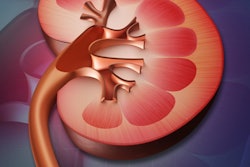Contrast media is often blamed for what appears to be contrast-induced nephropathy (CIN) in patients getting CT scans. But Chinese researchers have found that elevated rates of serum creatinine -- a marker for CIN -- can occur after CT even in patients who never receive contrast.
There are lots of reasons why patients could have higher serum creatinine levels after CT exams, according to two studies presented by researchers from Peking University First Hospital in Beijing at the 2013 International Symposium on Multidetector-Row CT. Clarifying those reasons is critical, according to the group.
"There are many factors affecting creatinine levels, especially among inpatients," said Dr. Xiaoying Wang in her presentation. "Many patients have severe diseases where, due to the disease, doctors find it is not appropriate for them to have contrast-enhanced CT."
Nailing down renal impairment
The findings don't necessarily fit with conventional wisdom on contrast-induced nephropathy; however, they do highlight the multifactorial nature of impaired renal function and remind clinicians that several factors must be present for a CIN diagnosis, Wang said.
"The definition of CIN is clear and simple, but in practice it's not easy to define," she said. CIN requires an absolute or relative increase in serum creatinine (SCr) compared to baseline values, a temporal relationship between the rise in SCr and exposure to a contrast agent, and the exclusion of alternative explanations for renal impairment -- which means looking for these explanations.
"Generally, as radiologists it is easy for us to detect an increase in serum creatinine, but it is not very easy for us -- sometimes not even easy for nephrologists -- to exclude alternative reasons for renal impairment," Wang said.
In an effort to identify at-risk patients, in Wang's practice, patients making appointments for contrast-enhanced CT are asked about a range of factors suggestive of CIN risk. The literature shows higher levels of risk for patients with a history of diabetes mellitus, hypertension, renal impairment, liver disease, renal-toxic medications, and a few other circumstances, though the studies used to identify the risk factors involved intra-arterial injection of contrast agents, Wang said.
Study 1: Are at-risk patients really more at risk for CIN?
For patients undergoing contrast-enhanced CT between 2010 and 2012, her group analyzed the association between risk factors and the subsequent development of CIN. The researchers examined a total of 2,556 patients, of whom 1,243 formed an observation group. The patients were measured for SCr before contrast-enhanced CT as well as 48 to 72 hours after CT; if SCr levels rose by the second test, the patient was referred to a nephrologist, and SCr was measured again seven to 10 days later.
In all, 68 (5.5%) of the 1,243 patients were diagnosed with CIN, including 12 with acute renal failure. (Fifty-one patients recovered and five were lost to follow-up.) However, the study showed no statistically significant difference in the development of CIN between the patients with risk factors and those without.
Of the patients who were not at risk, 4.5% (17/375) developed CIN, while in the at-risk group, 5.9% (51/868) developed the condition (p = 0.21). Among patients with no history of chronic kidney disease, only female gender (p = 0.03) and the use of low-osmolar contrast media (p = 0.03) were associated with a significantly increased risk of CIN.
Logistic regression analysis of risk factors showed several that increased the odds of CIN, including a history of diabetes mellitus (odds ratio [OR] = 1.83), history of tumor (OR = 1.54), use of nephrotoxic drugs (OR = 1.69), frequent use of contrast media (OR = 1.13), and use of low-osmolarity contrast media (OR = 2.28). In addition, women had an odds ratio of 1.69, and those older than 75 had an odds ratio of 1.26. The difference was only statistically significant in women (p = 0.04), however.
"These [risk] factors are not very strong to [predict] the incidence of CIN," Wang said.
Study 2: Is 'CIN' risk really higher after noncontrast CT?
To continue to refine risk-factor prediction, the group recently completed a prospective cohort study of 623 patients who underwent CT with and without contrast. Of the 623 patients, 171 formed an observation group that received multiple SCr tests to allow the nephrologist to confirm a temporal association between increased SCr and contrast administration.
Among these 171 patients, 99 underwent contrast-enhanced CT and 72 had CT without contrast. There was no statistically significant difference in demographics and CIN-related risk factors between the 171 patients and the remaining 452, Wang said.
In all, 17 (9.9%) of the 171 patients developed what appeared to be CIN. Dividing up the patients between those who received contrast and those who did not, seven (7.1%) of the 99 who got contrast developed CIN. Meanwhile, 10 (13.9%) of the 72 patients who did not receive contrast developed "CIN." Again, the difference in CIN rates between those who did and did not receive contrast was not statistically significant (p = 1.414).
Many factors affect creatinine levels, especially among those like the inpatients in this study, who have a wide range of medical conditions and are prescribed a variety of medications, Wang concluded. Even factors ranging from higher muscle mass to recent ingestion of cooked meat can result in higher SCr levels.
"That's how we explain the higher SCr levels among noncontrast CT patients," she said. "The increase of serum creatinine level after CT examination may occur without iodine contrast administration."
She cautioned, though, that the sample sizes were small in both studies.
Excluding alternative explanations for renal impairment is crucial for diagnosing CIN, Wang concluded, and large, prospective cohort studies are needed to determine the true incidence of CIN in contrast-enhanced CT.




















